|
|
|
Sort Order |
|
|
|
Items / Page
|
|
|
|
|
|
|
| Srl | Item |
| 1 |
ID:
091512
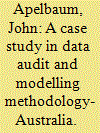

|
|
|
|
|
| Publication |
2009.
|
| Summary/Abstract |
The purpose of the paper is to outline a rigorous, spatially consistent and cost-effective transport planning tool that projects travel demand, energy and emissions for all modes associated with domestic and international transport. The planning tool (AuseTran) is a multi-modal, multi-fuel and multi-regional macroeconomic and demographic-based computational model of the Australian transport sector that overcomes some of the gaps associated with existing strategic level transport emission models. The paper also identifies a number of key data issues that need to be resolved prior to model development with particular reference to the Australian environment. The strategic model structure endogenously derives transport demand, energy and emissions by jurisdiction, vehicle type, emission type and transport service for both freight and passenger transport. Importantly, the analytical framework delineates the national transport task, energy consumed and emissions according to region, state/territory of origin and jurisdictional protocols, provides an audit mechanism for the evaluation of the methodological framework, integrates a mathematical protocol to derive time series FFC emission factors and allows for the impact of non-registered road vehicles on transport, fuel and emissions.
|
|
|
|
|
|
|
|
|
|
|
|
|
|
|
|
| 2 |
ID:
109706
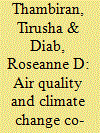

|
|
|
|
|
| Publication |
2011.
|
| Summary/Abstract |
Industries in Durban, South Africa, are a major source of air pollutant emissions and large users of fossil fuel based energy. Durban's energy strategy prioritises energy efficiency at industries as a key action, whilst industries are also the focus of the city's air quality management plan (AQMP). In this paper, measures that have been introduced in industries in Durban to effect air quality improvements and reduce energy consumption are examined in terms of their respective impacts on greenhouse gas (GHG) and air pollutant emissions. It was found that co-benefits for GHG mitigation were achieved when petroleum refineries switched from using heavy fuel oil to refinery gas and methane rich gas. Within other industries, co-benefits for air quality stemmed from reducing fossil fuel energy consumption and the improved efficiency of combustion systems. Air quality and energy policies in the city are being executed independently, without consideration of the trade-offs or synergies of the interventions being implemented. Recommendations are made for authorities and industries to consider the co-benefits for GHG mitigation in their AQMPs and where these are not possible to consider offsetting the increased GHG emissions through improved alignment with energy strategies.
|
|
|
|
|
|
|
|
|
|
|
|
|
|
|
|
| 3 |
ID:
127871


|
|
|
|
|
| Publication |
2014.
|
| Summary/Abstract |
In order to meet its 2050 target of 80% carbon emissions reduction, the UK is facing a challenge of restructuring its energy system, possibly by introducing more decentralised energy (DE) systems.Following semi-structured interviews, four exemplar international cases have been critiqued in order to investigate the variety and interrelationship of the drivers and barriers involved during their implementation, and then compared with the barriers and drivers that can potentially affect the implementation of similar projects in the UK context. The impacts of the barriers on the outcomes of these projects were evaluated, and recommendations were presented on overcoming these barriers if replicating similar projects in the UK context. Governance drivers play the most significant role, whereas financial drivers (commonly believed to be crucial), are deemed to play a lesser role. Social, governance and financial barriers rather than technological barriers constitute the central problem areas for the increased adoption of DE. The drivers and barriers experienced in the international cases were similar to those anticipated in the UK. The case studies present a high potential for replication and scaling up in the UK context and demonstrate that the increased implementation of DE systems could also enhance social and governance benefits.
|
|
|
|
|
|
|
|
|
|
|
|
|
|
|
|
| 4 |
ID:
116703


|
|
|
|
|
| Publication |
2012.
|
| Summary/Abstract |
A projection of future energy consumption is a vital input to many analyses of economic, energy, and environmental policies. We provide a benchmark projection which can be used to evaluate any other projection. Specifically, we base our projection of future energy consumption on its historical trend, which can be identified by an experience model. We compare our projection with forecasts by the U.S. Energy Information Administration (EIA) for eight countries-U.S., China, India, Brazil, Japan, South Korea, Canada, and Mexico. We find that the EIA's projections are lower than ours in the case of China, the U.S., India, Japan, and Mexico. This indicates that for these five countries, the EIA uses assumptions which cannot be rationalized by historical data.
|
|
|
|
|
|
|
|
|
|
|
|
|
|
|
|
| 5 |
ID:
169713
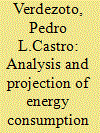

|
|
|
|
|
| Summary/Abstract |
A forecast model for the Ecuador energy sector was elaborated, by using LEAP model, this study aims to analyze the behavior of the energy matrix depending on energy forecast and efficiency policy scenarios, applying a bottom-up analysis and considering the latest politics/infrastructure planning background in Ecuador. The model and considerations proposed will result in a final energy consumption of 158 million BOE in 2030, in which the transportation sector is the main energy consumer. Regarding Ecuador energy planning, of which a critical point is the hydroelectricity available due to the commissioning of new hydro power plants, estimated at 63,513 Gwh in 2030, this value is 3.25 times that generated in 2010. In addition, the energy saving of 15 million BOE is forecast, as well as the reduction in GHG emission related to that saving due to the energy efficiency program PEC, which replaces LPG stoves with induction stoves in Ecuadorian households. Results point out that energy efficiency policies for the transportation sector would reduce oil products (2.97% in the high growth scenario), which could be reallocated to the industrial sector. Finally, another critical point is the rapid decline in the oil self-sufficiency, estimated at 15 years counted from 2030.
|
|
|
|
|
|
|
|
|
|
|
|
|
|
|
|
| 6 |
ID:
088202
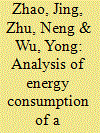

|
|
|
|
|
| Publication |
2009.
|
| Summary/Abstract |
According to statistics and field investigation, the energy consumption situation and reality of commercial building is described in this paper. As the first step of large-scale public building energy efficiency supervision system encouraged by central government of China, the energy consumption of several typical commercial buildings and public buildings was analyzed in detail. The main contents of investigation are as follows: basic information of building, operational record of energy consumption equipment, energy consumption of indoor equipments, energy-efficiency assessment of energy consumption systems and equipments, investigation of behavior energy saving, etc. On this basis further analysis and diagnosis including indoor thermal and humid environment, operation state of air-conditioning water system, operation state of air-conditioning duct system and operation management of air-conditioning system were implemented. The results show that the most energy consumption of buildings in this city is commercial buildings, which can reach to about 240 W/m2 per year. Further analysis tells that air conditioning systems play the major role of building energy consumption, and building energy saving has great potential in this city. In this paper, the ways of diagnosis work for building energy consumption are also described and discussed. Reasonable test, diagnosis and analysis are meaningful for building energy efficiency retrofit and management.
|
|
|
|
|
|
|
|
|
|
|
|
|
|
|
|
| 7 |
ID:
090075
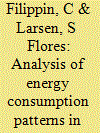

|
|
|
|
|
| Publication |
2009.
|
| Summary/Abstract |
This paper analyzes the energy consumption during the period 2001-2006 of 192 flats distributed in three-storey buildings, in order to understand how current policies related to energy use could be improved for increased residential energy efficiency in Argentina. The buildings (1, 2 and 3 bedrooms) are located in La Pampa, central Argentina, in a moderate cold climate. The dimensional and energy-consumption variables are studied (area, envelope's area, FAEP=envelope's area/floor area; envelope's thermal resistance R, volumetric heat loss G and auxiliary heating Qaux). The natural gas consumption is analyzed at annual and seasonal levels. Consumption variability among buildings, storeys and flats is calculated. The quantitative analysis is coupled to a qualitative description through direct observation of the buildings. The results show: (a) a high incidence of natural gas consumption in the total annual energy consumption (natural gas+electricity), (b) seasonality of natural gas consumption, with a maximum value in the cold period July-August (variability=80%), (c) little variability among buildings of the annual natural gas consumption (4.17%), (d) the lowest average energy consumption at the first floor, (e) high variability among flats on each storey, (f) winter consumption of a multi-family dwelling lower than a single-family dwelling of similar area and (g) little seasonal variability of the electricity consumption.
|
|
|
|
|
|
|
|
|
|
|
|
|
|
|
|
| 8 |
ID:
097254
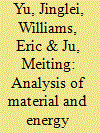

|
|
|
|
|
| Publication |
2010.
|
| Summary/Abstract |
Owing to booming mobile phone ownership and a short product innovation cycle, waste mobile phones are flooding China. In 2008, about 560 million mobile phones were produced and 634 million users subscribed to a mobile phone plan in China. These large numbers mean that the charging and disposal of mobile phones has the potential to have significant impacts on the environment. Thus the evaluation of material and energy consumption of mobile phones is an important task in the end-of-life management of electronic products. This paper uses material flow analysis (MFA) and life cycle assessment (LCA) methods to estimate the life cycle impacts of mobile phones in China from manufacturing energy, use phase and generation of waste mobile phones. Results indicate over the mobile phone life cycle, manufacturing accounts for 50% of the total energy consumption, whereas the use phase accounts for only 20%. Mobile phones and supporting infrastructures account for a rapidly increasing 0.17% of Chinese energy use. In 2008, around 77 million units of waste mobile phones were generated in China. To manage this energy use and recover valuable materials recommendations are made to increase lifespan, improve energy efficiency during use and ensure recycling.
|
|
|
|
|
|
|
|
|
|
|
|
|
|
|
|
| 9 |
ID:
132660


|
|
Analysis of monthly household energy consumption among single-f
/ Valenzuela, Carlos; Valencia, Alelhie; White, Steve; Jordan, Jeffrey A, Cano, Stephanie, Keating, Jerome, Nagorski, John, Potter, L.B
|

|
|
|
|
| Publication |
2014.
|
| Summary/Abstract |
Demographic, socioeconomic, and housing characteristics influence variation in household energy consumption. By combining household-level utility, public, and proprietary data, we examine predictors of household energy consumption in a Texas urban area. Using quantile regression, this analysis assesses the relationship between energy consumption and predictors at the middle and both ends of the distribution (10th and 90th percentiles). Results indicate potential opportunities to lower consumption among the highest energy-consuming households including those with pools, with non-central cooling, with people working from home, those built on pier/post foundation, and those that are renter-occupied. These findings suggest significant opportunities to reduce consumption and demand as in the study area, almost 10% of housing units are renter-occupied, 18% percent are without central cooling, and 7% have pools. Capturing a significant portion of these homes for retrofit conservation efforts through marketing has potential to produce substantial results. Producing a better understanding of determinants of household energy consumption using the methods presented has potential to assist development and implementation of strategies to reduce consumption and increase efficiency.
|
|
|
|
|
|
|
|
|
|
|
|
|
|
|
|
| 10 |
ID:
127907


|
|
|
|
|
| Publication |
2014.
|
| Summary/Abstract |
This paper introduces a new agent-based model, which incorporates the actions of individual homeowners in a long-term domestic stock model, and details how it was applied in energy policy analysis. The results indicate that current policies are likely to fall significantly short of the 80% target and suggest that current subsidy levels need re-examining. In the model, current subsidy levels appear to offer too much support to some technologies, which in turn leads to the suppression of other technologies that have a greater energy saving potential. The model can be used by policy makers to develop further scenarios to find alternative, more effective, sets of policy measures. The model is currently limited to the owner-occupied stock in England, although it can be expanded, subject to the availability of data.
|
|
|
|
|
|
|
|
|
|
|
|
|
|
|
|
| 11 |
ID:
128035


|
|
|
|
|
| Publication |
2014.
|
| Summary/Abstract |
Gujarat, a large industrialized state in India, consumed 67 TWh of electricity in 2009-10, besides experiencing a 4.5% demand-supply short-fall. Residential sector accounted for 15% of the total electricity consumption. We conducted load research survey across 21 cities and towns of the state to estimate residential electricity load curves, share of appliances by type and usage patterns for all types of household appliances at utility, geographic, appliance, income and end-use levels. The results indicate that a large scope exists for penetration of energy efficient devices in residential sector. Marginal Abatement Cost (MAC) curves for electricity and CO2 were generated to analyze relative attractiveness of energy efficient appliance options. Results indicate that up to 7.9 TWh of electricity can be saved per year with 6.7 Mt-CO2 emissions mitigation at negative or very low CO2 prices of US$ 10/t-CO2. Despite such options existing, their penetration is not realized due to myriad barriers such as financial, institutional or awareness and therefore cannot be taken as baseline options for CO2 emission mitigation regimes.
|
|
|
|
|
|
|
|
|
|
|
|
|
|
|
|
| 12 |
ID:
176771


|
|
|
|
|
| Summary/Abstract |
With rapidly expanding real GDP in Vietnam, it is anticipated that the Vietnamese energy production will increase to meet its rising energy consumption. An important corollary is that pollution will also rise since the energy sector is considered a big polluter in the developing world. This paper brings two important insights to this literature: first and foremost, this paper seeks to establish if any behavioural biases of policy makers have clouded the decision to adopt suitable energy technologies and policies in Vietnam with far-reaching consequences for sustainability in the region. Secondly, in order to detect behavioural biases, it considers the asymmetric effects of increases vis-à-vis decreases in regressors by using the non-linear autoregressive distributed lags (NARDL) models, to examine how such increases or decreases really impact on pollution in Vietnam. Using annual data from 1982 to 2015, the analysis finds that the long-run relationships between pollution, energy use and oil prices have been characterised by non-linear and asymmetric interlinkages to indicate hidden cointegration. We further argue that such hidden cointegration can signal important behavioural biases in (energy) policy-making.
|
|
|
|
|
|
|
|
|
|
|
|
|
|
|
|
| 13 |
ID:
162972
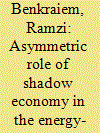

|
|
|
|
|
| Summary/Abstract |
This paper estimates the energy demand function to examine the asymmetric relationship between the shadow economy and energy consumption in the case of Bolivia during the period of 1960–2015. The ambiguous empirical findings on shadow economy-energy demand nexus has inclined us to apply the nonlinear ARDL cointegration approach developed by Shin et al. (2014) and the Hatemi-J (2012) asymmetric causality test. The empirical evidence confirms the presence of an asymmetric relationship between the variables of interest. Positive and negative shocks to official GDP (true GDP) and the shadow economy have positive impacts on energy consumption. Energy consumption is positively and negatively affected by positive and negative shocks in financial development, respectively. A positive (negative) shock to capital decreases energy consumption. Another important finding concerns the complex causal direction between economic growth and energy consumption. This study provides new insights regarding to the use of official GDP (true GDP) and the shadow economy as economic tools to maintain energy demand for sustainable economic development.
|
|
|
|
|
|
|
|
|
|
|
|
|
|
|
|
| 14 |
ID:
091571


|
|
|
|
|
| Publication |
2009.
|
| Summary/Abstract |
Crude oil is a limited natural resource subject to depletion and several reports indicate that the world's crude oil production is close to the maximum level and that it will start to decrease after reaching this maximum. A post-Kyoto political agenda to reduce oil consumption will have the same effect on aviation fuel production as a natural decline in the crude oil production. On the other hand, it is predicted by the aviation industry that aviation traffic will keep on increasing.
|
|
|
|
|
|
|
|
|
|
|
|
|
|
|
|
| 15 |
ID:
038962
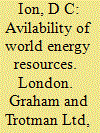

|
|
|
|
|
| Publication |
London, Graham and Trotman Ltd, 1975.
|
| Description |
234p
|
| Standard Number |
0860100154
|
|
|
|
|
|
|
|
|
|
|
|
Copies: C:1/I:0,R:0,Q:0
Circulation
| Accession# | Call# | Current Location | Status | Policy | Location |
| 016352 | 333.7/ION 016352 | Main | On Shelf | General | |
|
|
|
|
| 16 |
ID:
136231


|
|
|
|
|
| Summary/Abstract |
The building sector of China currently consumes 20% of the total energy consumption. Studies on barriers to the adoption of building energy-saving technologies are of great significance on implementing policies related to achieving energy-saving goals. This paper studied 15 barriers with the aid of information collected through questionnaires and semi-structured interviews. The respondents were 135 employees working in the Jing-jin-tang area. Based on the results of the factor analysis, the barriers were categorized into five groups: attitudes of stakeholders, policies and regulations, auxiliary resources, profitability, and adaptability of the technologies. Analysis of the entire sample showed that the stakeholders’ reluctance to use was the largest barrier, followed by high initial investment and low profitability. Further analysis showed that the occupation and designation of the respondents and the size of the enterprises that they served influenced their perspectives on the barriers. It was found that architects attributed more importance to the adoption of energy-saving technologies than contractors; barriers confronted by employees of large enterprises and small enterprises were different; managers perceived weaker barriers than frontline employees and were more optimistic about the prospect of building energy-saving technologies. Finally, policy recommendations were proposed based on these in-depth and targeted analyses.
|
|
|
|
|
|
|
|
|
|
|
|
|
|
|
|
| 17 |
ID:
127869


|
|
|
|
|
| Publication |
2014.
|
| Summary/Abstract |
As the President of the Office of Competition and Consumer Protection refused to approve a government initiated takeover in the Polish power sector and the Court of Competition and Consumer Protection did not make a ruling on that case, the takeover was finally prohibited. In this context, the main aim of this paper is to carry out a quantitative analysis of the impact of the takeover in question on electricity prices and quantities, consumer and producer surpluses, dead weight loss and emissions. The scope of the study covers the Polish power generation sector and the analysis was carried out for 2009. A game theory-based electricity market equilibrium model developed for Poland was applied. The model includes several country-specific conditions, such as a coal-based power generation fuel-mix, a large share of biomass co-combustion, etc. For the sake of clarity, only four scenarios are assumed. The paper concludes that the declared synergy savings did not compensate for the increase in dead weight loss and the transfer of surplus from consumers to producers caused by increased market power.
|
|
|
|
|
|
|
|
|
|
|
|
|
|
|
|
| 18 |
ID:
128722


|
|
|
| 19 |
ID:
132602
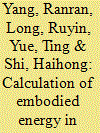

|
|
|
|
|
| Publication |
2014.
|
| Summary/Abstract |
In order to find efficient trade measures to reduce China×s energy consumption and to provide theoretical support for the climate talks between China and America, we investigate the impact of Sino-USA trade on energy consumption from the perspective of embodied energy. An Environmental Input-Output Life Cycle Assessment (EIO-LCA) model was established to calculate the total energy consumption coefficient, the direct consumption coefficient and the complete consumption coefficient of the sectors of the national economies of China and America. After taking into consideration the data of every sector of the national economy in Sino-USA trade, energy embodied in the import and export trade between China and America was calculated to verify the real energy flows in Sino-USA trade. The research results suggest the following: China is the net exporter of embodied energy in Sino-USA trade, and coal, crude oil and natural gas are the major components. In 1997-2011, the net exports of China×s embodied energy totaled 1523,082,200 t of standard coal, the amount of China×s energy consumption increased by 895,527,900 t of standard coal, and America×s energy consumption decreased by 11,871,200 t of standard coal as a result of Sino-USA trade. On this basis, corresponding policies and recommendations are proposed.
|
|
|
|
|
|
|
|
|
|
|
|
|
|
|
|
| 20 |
ID:
150005


|
|
|
|
|
| Summary/Abstract |
This study investigates the long and short run relationships among carbon emissions, energy consumption and economic growth in India at the aggregated and disaggregated levels during 1971–2014. The autoregressive distributed lag model is employed for the cointegration analyses and the vector error correction model is applied to determine the direction of causality between variables. Results show that a long run cointegration relationship exists and that the environmental Kuznets curve is validated at the aggregated and disaggregated levels. Furthermore, energy (total energy, gas, oil, electricity and coal) consumption has a positive relationship with carbon emissions and a feedback effect exists between economic growth and carbon emissions. Thus, energy-efficient technologies should be used in domestic production to mitigate carbon emissions at the aggregated and disaggregated levels. The present study provides policy makers with new directions in drafting comprehensive policies with lasting impacts on the economy, energy consumption and environment towards sustainable development.
|
|
|
|
|
|
|
|
|
|
|
|
|
|
|
|
|
|
|
|
|